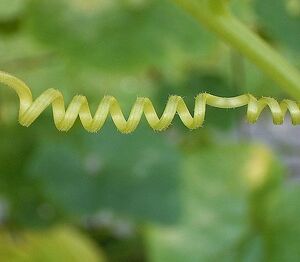Tendril perversion (nonfiction): Difference between revisions
No edit summary |
No edit summary |
||
| (3 intermediate revisions by the same user not shown) | |||
| Line 1: | Line 1: | ||
Tendril perversion, often referred to in context as simply perversion, is a geometric phenomenon found in helical structures such as plant tendrils, in which a helical structure forms that is divided into two sections of opposite chirality, with a transition between the two in the middle. A similar phenomenon can often be observed in kinked helical cables such as telephone handset cords. | [[File:Cucurbita_pepo_tendril_perversion.jpg|thumb|''Cucurbita pepo'' exhibiting tendril perversion.]][[File:Telephone cord tendril perversion.jpg|thumb|A telephone handset cord exhibiting tendril perversion.]]'''Tendril perversion''', often referred to in context as simply '''perversion''', is a geometric phenomenon found in helical structures such as plant tendrils, in which a helical structure forms that is divided into two sections of opposite chirality, with a transition between the two in the middle. A similar phenomenon can often be observed in kinked helical cables such as telephone handset cords. | ||
The phenomenon was known to Charles Darwin, who wrote in 1865, | The phenomenon was known to [[Charles Darwin (nonfiction)|Charles Darwin]], who wrote in 1865, | ||
<blockquote>A tendril ... invariably becomes twisted in one part in one direction, and in another part in the opposite direction... This curious and symmetrical structure has been noticed by several botanists, but has not been sufficiently explained.</blockquote> | <blockquote>A tendril ... invariably becomes twisted in one part in one direction, and in another part in the opposite direction... This curious and symmetrical structure has been noticed by several botanists, but has not been sufficiently explained.</blockquote> | ||
The term "tendril perversion" was coined by Goriely and Tabor in 1998 based on the word perversion found in the 19th Century science literature . "Perversion" is a transition from one chirality to another and was known to James Clerk Maxwell, who attributed it to the topologist J. B. Listing. | The term "tendril perversion" was coined by Goriely and Tabor in 1998 based on the word perversion found in the 19th Century science literature . "Perversion" is a transition from one chirality to another and was known to [[James Clerk Maxwell (nonfiction)|James Clerk Maxwell]], who attributed it to the topologist J. B. Listing. | ||
Tendril perversion can be viewed as an example of spontaneous symmetry breaking, in which the strained structure of the tendril adopts a configuration of minimum energy while preserving zero overall twist. | Tendril perversion can be viewed as an example of spontaneous symmetry breaking, in which the strained structure of the tendril adopts a configuration of minimum energy while preserving zero overall twist. | ||
| Line 30: | Line 30: | ||
== Nonfiction cross-reference == | == Nonfiction cross-reference == | ||
* [[Charles Darwin (nonfiction)]] | |||
* [[James Clerk Maxwell (nonfiction)]] | |||
* [[Topology (nonfiction)]] | * [[Topology (nonfiction)]] | ||
Latest revision as of 19:21, 5 May 2018
Tendril perversion, often referred to in context as simply perversion, is a geometric phenomenon found in helical structures such as plant tendrils, in which a helical structure forms that is divided into two sections of opposite chirality, with a transition between the two in the middle. A similar phenomenon can often be observed in kinked helical cables such as telephone handset cords.
The phenomenon was known to Charles Darwin, who wrote in 1865,
A tendril ... invariably becomes twisted in one part in one direction, and in another part in the opposite direction... This curious and symmetrical structure has been noticed by several botanists, but has not been sufficiently explained.
The term "tendril perversion" was coined by Goriely and Tabor in 1998 based on the word perversion found in the 19th Century science literature . "Perversion" is a transition from one chirality to another and was known to James Clerk Maxwell, who attributed it to the topologist J. B. Listing.
Tendril perversion can be viewed as an example of spontaneous symmetry breaking, in which the strained structure of the tendril adopts a configuration of minimum energy while preserving zero overall twist.
Tendril perversion has been studied both experimentally and theoretically. Gerbode et al. have made experimental studies of the coiling of cucumber tendrils. A detailed study of a simple model of the physics of tendril perversion was made by MacMillen and Goriely in the early 2000s. Liu et al. showed in 2014 that "the transition from a helical to a hemihelical shape, as well as the number of perversions, depends on the height to width ratio of the strip's cross-section."
Generalized tendril perversions were put forward by Silva et al., to include perversions that can be intrinsically produced in elastic filaments, leading to a multiplicity of geometries and dynamical properties.
In the News
Fiction cross-reference
- Crimes against mathematical constants
- Gnomon algorithm
- Gnomon Chronicles
- Gnotilus - mathematical function which suffers from Tendril perversion
- Mathematician
- Mathematics
- Tendril perversion - a criminal act committed by artificial intelligences and rogue mathematical functions, often accompanied by cryptographic numen events.
Nonfiction cross-reference
External links:
- Tendril perversion @ Wikipedia

